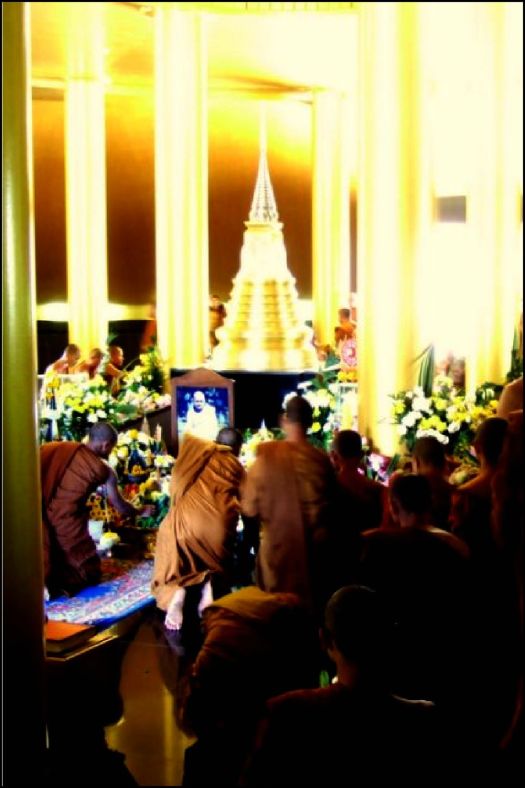By the time you read this I’ll be in Thailand. The 16th January will mark the twenty-sixth anniversary of Ajahn Chah’s passing, and, as usual, I will be accompanying Luangpor as he and fellow monks, nuns and lay followers from Thailand and abroad gather at Wat Pah Pong to remember their teacher.
Far from the annual event fading over time, as you might expect, it actually seems to be growing. Indeed, it’s now one of the biggest events in the province of Ubon. Just think about that for a second: tens of thousands of people gathering to celebrate virtue, kindness and wisdom – the qualities which Ajahn Chah both taught and embodied. How often does something like that happen in this world?
To add to the occasion, in June it will have been Ajahn Chah’s 100th birthday. Over the last few years, in readiness for next week, monks from Wat Pah Pong have led the construction of an Ashokan-style solid limestone carved pillar at the place of his birth, just a mile or so from the monastery; and, to ensure that people find their way, the road that links the two has been lined with about 10,000 sunflowers. By the time devotees arrive at the column, there’s no way they won’t be smiling.
As is the case with countless people, Ajahn Chah’s teachings have had a profound impact on me. In fact, I don’t think I’d be exaggerating if I were to say that had it not been for his words I wouldn’t have made it this far as a monk. Confused, despairing or full of doubt: whenever I’ve been at a low ebb I’ve picked up Food for the Heart or Living Dhamma or one of the other slim, unassuming books with no price tag and sat down and flicked to a random page. Five minutes later and I’ll be grounded and sure of my purpose. Together with Luangpor, I regard him as my main teacher.
Of course, I never met him. He passed away in 1992 and because of illness hadn’t taught for 10 years before that. But when I read him I feel I know him. And, what’s more, it’s as if he knows me and what I’m going through, because, judging by all accounts, it’s likely he went through something similar himself. And even when I’ve put down the book, and I’m sweeping out in the cold, or sitting impatiently waiting for the meal, or becoming frustrated with my meditation practice, he’s still there in my mind: nagging me, encouraging me, advising me. His similes and stories occupy their own little corner of my head, and whenever I’m confronted with a particular problem: out pops the relevant quote to the rescue.
There are countless gems to be found in his Dhamma talks – from a quote of three words, to an epic tale about his experiences confronting tigers in the forest. And there’s the endless list of accounts passed down by his students. But here and in some future posts I’d like to mention just a few teachings that have been particularly useful to me. I should also add that I haven’t actually read anything of his (except for the odd quote that has appeared somewhere) for quite some time; and so what follows are stories and teachings which, owing to their relevance to my own practice, have percolated to the top.
Same for me!
Luangpor spent over five years living close to Ajahn Chah – either with him, at Wat Pah Pong, or in one of the many branch monasteries in the North East of Thailand. And so, as anyone who has spent some time here at the Hermitage will testify, he is not short of classic Ajahn Chah stories. And because I’ve spent most of my seventeen monastic years living with Luangpor, I know most of them off by heart. This is one.
It’s common – indeed expected – for new monks to struggle from time to time. Doubt, lust, boredom, restlessness, homesickness, sitting all day dreaming of bananas: far from being a peaceful existence, the early stages (and sometimes the latter ones, too!) can be, as Ajahn Chah said, like ‘walking into a raging storm’. Consequently, if a junior monk is seen to spend his days floating around the monastery, bestowing beatific smiles upon his fellows in the holy life, it can be guessed that he’s not doing it right. Anyway, on one occasion Luangpor was – as we say – going through it, and somehow word of his struggles got to Ajahn Chah.
Thus, one evening, when the community was gathered beneath Ajahn Chah’s kuti, Luangpor, a junior monk who had been sitting inconspicuously in the outer rows, was suddenly called forward into the spotlight. Ajahn Chah wanted to know what was wrong. And so Luangpor tried to describe, as best he could in his halting Thai, what he was experiencing. When he had finished, Ajahn Chah leaned forward from his trusty rattan seat, beaming at Luangpor and pointing to himself, and simply said, ‘Same for me!’
That was all he said, and it worked. Luangpor’s troubles didn’t vanish on the spot, but the knowledge that this great monk with the unshakable mind had been through the wringer gave him a much-needed boost in patience, determination and, most importantly, hope.
Rock Solid
Hanging on the wall of Luangpor’s kuti is a rare photograph of Ajahn Chah sitting on that very same rattan seat. His bare feet are on the concrete, his hands are flat on the seat either side of his hips, and he’s leaning forward slightly while looking at the photographer. It’s an unremarkable photo in all respects except for one: his expression.
When I first saw it my immediate impression was that this was a man who could have handled anything. Don’t get me wrong: he isn’t flexing his muscles and scowling. On the contrary, he looks utterly relaxed and at ease – like there’s absolutely nowhere else he’d rather be than sitting on that simple seat on the plain concrete floor in the middle of the forest. But there’s something else in his expression, something immovable and unshakeable. It’s an expression that says, ‘Try me,’ knowing full well that to do so would be futile. And somehow you can also tell that this unassailable peace of mind was hard-won; that it was a product of unremitting perseverance and dedication; that it arose as a direct result of having been through, and having seen though, it all.


 .
.

